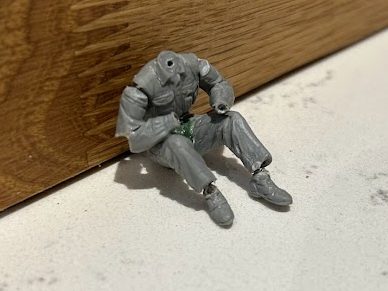The Plastic Posse podcast sometimes discuss ‘opus builds’, meaning (I think) a project that is to be your ‘great work’. This project is something that I’ve been pondering for a while and is probably a first attempt at my ‘opus build’. The idea stems from a story regarding a former RSM of my regiment whilst he was commanding a vehicle in Afghanistan. During a patrol their troop took several casualties and his vehicle was used to transport them to a helicopter landing site to be evacuated. Once this had been done he sent off his soldiers to get some food, they returned to find he had cleaned the vehicle in their absence so they wouldn’t have to go back on patrol with their friends’ blood around them. It’s a striking story, certainly one of the best examples of leadership I’ve come across during my service. It also makes me think of the scene in the movie Fury, where Brad Pitt’s character forces the newcomer to clean the remains of a crewman from the inside of the tank. It is one of the many times where the film dehumanises its cast in an attempt to be ‘gritty’, losing something in the process. I wanted to try to transpose the story from Afghanistan to a WW2 setting and provide something of an antidote to that scene in Fury, depicting a commander who cared for his crew by doing the ‘hard bits’ rather than trying to dehumanise them to his level.

I have spent a long time wondering how to convey the key elements of this scene, the idea of a commander caring for his crew in this way. I toyed with a number of ideas, one was to build a full tank and have the crew on one side and the commander on the other, others involved footsteps or a cooking fire. The main obstacle to them was the lack of figures in the right poses. I’ve only just got to the point where I’m happy painting figures, sculpting has always been a rather intimidating prospect. Then, one night, I decided to give it a bash, pulled out some miniart tank crew I had on a shelf and started playing with them. Honestly my lack of skill is such that there isn’t much point in me explaining the process, other to say that I found various limbs and a torso that looked like they would work, adjusted the position of the arms and legs and used putty to fill the gaps and create the clothing (initially green stuff, then magic sculpt, which is far superior). My main priority was to create a figure in what looked like a reasonably comfortable sitting position, head and shoulders slouched with his arms resting on his knees. I found a hornet head with a pith helmet that I modified by removing the helmet and adding hair, again with putty.


With that done I needed to find a way to convey what had happened. I am wary of including bodies in dioramas, there is a very fine line between accurate and gratuitous. Actually it might be more accurate to say that there is no way to be accurate without it feeling gratuitous and creating something one doesn’t actually want to look at. That is probably a topic for a blog post by itself! I decided to include a body but have it under a blanket, as though he had been removed from the vehicle by the commander and was awaiting burial. I used an old Tamiya German tank crew figure with a blanket made from pva soaked paper and just the boots showing at one end. Another choice I made that might be controversial was to not include the head. My logic here is that it was a reasonably common injury among tank crews and is a detail the viewer is likely to notice without it being telegraphed. I also added a resin bucket and rag, with some slightly red tinted water beside the figure to suggest the idea of cleaning the vehicle.

I made a foam base with a pattern of cobble stones and fixed down the tank and figures once I was happy with the composition. I also added some slightly red tinted ‘water’ spreading out from under the vehicle, as though the escape hatch on the belly had been used to let the water escape as the inside was washed. Again, I was hoping that this would be a subtle touch that adds a little to the overall picture. The red of the water blends in well with the cobbles, leaving the slight discolouration and glossy finish to allow the viewer to identify what it is supposed to be. Finally I added a rolled up belt with a pistol holster beside the figure to help suggest he was a commander.
I mounted the whole piece on a plinth from Oakwood Studios and fitted a plate from ‘nameit plates’ and called it finished. Overall I’m pretty pleased with the project, not least because it has helped me to shed some of my fear of sculpting and I’m now enthusiastically exploring ideas for projects I’d abandoned due to lack of appropriate figures. I think the piece offers enough clues about what has happened to allow the viewer to construct a story in their head, offering something that is poignant without being gross. It has also left me craving more opportunities to tell stories through my work, to the point where I’m considering abandoning something I’m working on because it doesn’t really offer the opportunity I am looking for. In all I can highly recommend trying re-sculpting figures as it dramatically broadens the options available to the modeller and is great fun.



